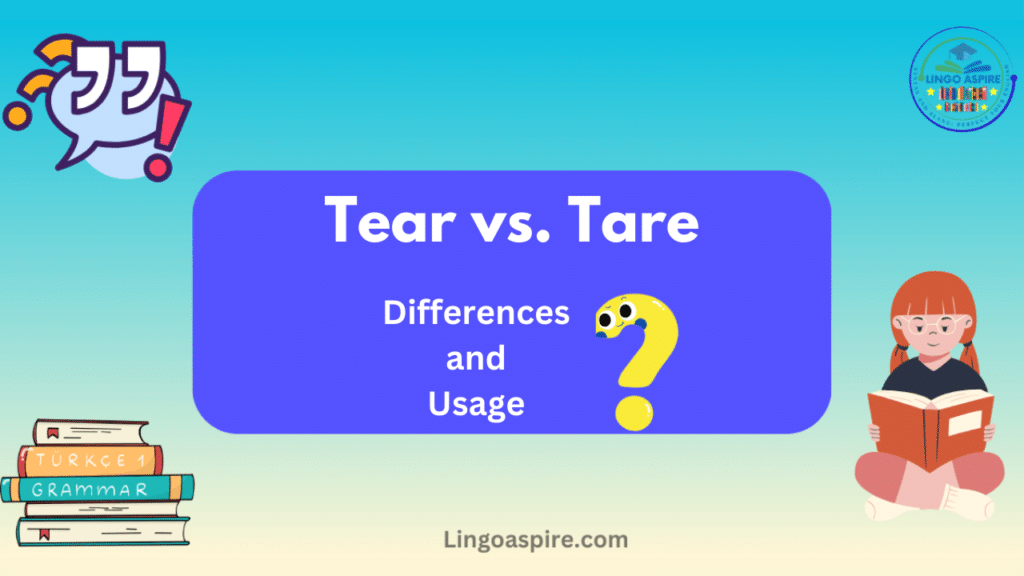The English language has many commonly confused words, and Tear vs. Tare is one of them. These words sound alike but have different meanings and uses. Understanding the difference between tear and tare is essential for correct usage in writing and speech. This article explains their definitions, pronunciation, meanings, and real-life usage. By the end, you’ll confidently know when to use “tear” and “tare” in different contexts.
Tear Meaning and Usage

Tear as a Verb
As a verb, tear means to rip, break, or damage something by pulling it apart. It refers to the physical act of forcefully separating an object. Examples include:
- She tried to tear the letter, but it was too thick.
- The strong wind tore the roof off the house.
- He tears the pages of his notebook when he’s frustrated.
This form of “tear” is used when describing physical tear, like ripping clothes, paper, or fabric.
Tear as a Noun
As a noun, tear has two meanings:
- A rip or hole in something:
- There was a tear in my jeans after I fell.
- The book has a small tear on the last page.
- A drop of liquid from the eyes caused by emotions:
- She wiped away a tear as she said goodbye.
- Tears streamed down his face during the movie.
This meaning refers to emotional tear, which happens when people cry due to sadness, joy, or pain.
Tear Pronunciation
- As a verb (to rip), it is pronounced /tɛr/ (rhymes with “bear”).
- As a noun (crying), it is pronounced /tɪər/ (rhymes with “deer”).
Tare Meaning and Usage
Tare as a Noun
As a noun, tare refers to the weight of a container, packaging, or material that holds an item, which must be subtracted to get the net weight. Examples include:
- The tare weight of the truck is 5,000 pounds.
- Always check the tare before measuring the ingredients.
- The machine automatically deducts the tare for accurate readings.
Tare as a Verb
As a verb, tare means to adjust a scale to account for the weight of the container. Examples include:
- The chef tares the scales before adding ingredients.
- Please tare the scale before weighing the flour.
- He forgot to tare the weight, so the reading was incorrect.
Tare Pronunciation
- Tare is pronounced /tɛr/ (same as “tear” when it means to rip).
Synonyms for Tear vs. Tare

| Word | Synonym | Meaning | Usage in a Sentence |
|---|---|---|---|
| Tear (verb) | Rip | To pull apart forcefully | She accidentally ripped the paper. |
| “ | Shred | To cut or tear into small pieces | He shredded the old documents. |
| “ | Split | To break apart into sections | The storm split the tree in two. |
| “ | Lacerate | To tear deeply or roughly | The sharp rock lacerated his skin. |
| Tear (noun – crying) | Weep | To shed tears | She began to weep after hearing the news. |
| “ | Sob | To cry noisily | He sobbed uncontrollably at the funeral. |
| Tare (noun – weight) | Deduction | A subtracted amount in weight measurement | The tare weight of the truck was 2,000 kg. |
| “ | Allowance | An adjustment for the weight of packaging | A tare allowance is applied in shipping. |
| Tare (verb – weight) | Subtract | To remove from the total weight | You need to subtract the tare before measuring. |
| Tare (noun – botany) | Weed | An unwanted plant in a field | Farmers remove tares to protect crops. |
| “ | Wild vetch | A plant similar to peas, often considered a weed | Tares grew among the wheat. |
| “ | Darnel | A type of weed harmful to crops | Darnel is sometimes mistaken for wheat. |
This table provides a detailed breakdown of synonyms for “tear” and “tare”, covering different meanings and contexts.
Key Differences Between Tear vs. Tare
| Feature | Tear | Tare |
|---|---|---|
| Part of Speech | Noun, Verb | Noun, Verb |
| Meaning | To rip or liquid from eyes | Weight of container |
| Pronunciation | /tɛr/ (rip), /tɪər/ (cry) | /tɛr/ |
| Examples | Tear a paper, shed a tear | Tare weight, tare a scale |
The difference between tear and tare is clear: “tear” relates to ripping or crying, while “tare” refers to weighing tare in measurements.
Common Mistakes and How to Avoid Them

Many people confuse “tear” and “tare” because they sound similar. Here are some common mistakes and ways to remember their meanings:
- Using “tear” instead of “tare” in weighing
- Incorrect: The tear of the package is 3 kg.
- Correct: The tare of the package is 3 kg.
- Using “tare” instead of “tear” for ripping
- Incorrect: He tared the paper into small pieces.
- Correct: He tore the paper into small pieces.
Memory Tricks
- “Tear something apart” → Think of ripping.
- “Tare weight” → Think of scales and weighing.
- “Tear (crying)” → Think of tears in the eyes.
Real-Life Usage of Tear and Tare
Case Study 1: “Tear” in Literature
The word tear appears often in books, poetry, and movies. One famous example is from Shakespeare:
“The quality of mercy is not strained; it droppeth as the gentle tears from heaven.”
— William Shakespeare
This poetic line uses tear to describe crying as a symbol of compassion.
Case Study 2: “Tare” in Business and Shipping
A shipping company must calculate the net weight vs tare weight when transporting goods. If a truck’s total weight is 20,000 pounds and its tare weight is 5,000 pounds, the net weight of the cargo is 15,000 pounds.
This process is essential in logistics, food packaging, and industrial weighing.
Easy Trick to Remember Tear vs. Tare

- Tear (related to breaking or crying) → Think of “tear apart” or “tears of joy.” If something rips or if you’re crying, the word you need is tear (pronounced “tair”).
- Tare (related to weight or plants) → Think of “tare weight” or “weeds in the field.” If you’re weighing something and need to subtract the container’s weight, or if you’re talking about unwanted plants (tares) in farming, then the word you need is tare (pronounced “tair”).
Memory Aid
- “Tear” = “Ripped Paper or Crying Eyes.”
- “Tare” = “Weight Subtraction or Weeds.”
This trick makes it easy to remember and use the words correctly in different contexts!
FAQs About Tear vs. Tare
1. What is the easiest way to remember the difference between tear and tare?
Remember that tear is related to ripping or crying, while tare is about weight measurement.
2. Can tare be used outside of weighing and measuring?
No, “tare” is mostly used in industrial, culinary, and scientific contexts.
3. How do you use tear and tare in a sentence correctly?
- He will tear the paper into pieces.
- The tare weight of the truck must be subtracted before loading.
Understanding these English vocabulary differences will help improve your grammar and prevent confusion in writing and speech.
Conclusion
Understanding tear vs. tare is important for correct English usage. Tear can mean “to rip” or “a drop from the eye,” while tare is used in weighing measurements. The grammar rules for tear and tare make it clear that they serve different purposes, even though they are similar sounding words.
You can use these words confidently now that you know the English vocabulary differences. Keep practicing by reading and writing sentences with “tear” and “tare.” The next time you weigh something or read an emotional book, you’ll know exactly which word to use!
Sources
- Merriam-Webster Dictionary: Merriam-Webster is one of the most authoritative English dictionaries. It provides accurate definitions, pronunciation guides, and usage examples for both “tear” and “tare.” This source ensures the article’s definitions are precise and backed by linguistic experts. Additionally, it helps clarify the differences between homophones and commonly confused words.
- Oxford Learner’s Dictionary: The Oxford Learner’s Dictionary is specifically designed for English learners, making it a great source for explaining difficult grammar rules and vocabulary simply. It provides clear definitions, synonyms, example sentences, and grammar explanations, which help support the article’s discussion on word usage, context, and spelling differences.
- National Institute of Standards and Technology (NIST): This official website is valuable for explaining the concept of tare weight in weighing and measurement systems. The NIST provides technical definitions and standards for terms like “tare” in the context of net weight vs. tare weight. This ensures that the explanation in the article is not only grammatically correct but also technically accurate.







